With over 56 million people on social media in the UK, it can be hard to stand out! There’s more to your online presence than just posting and hoping. Building a powerful brand is key to getting results and being remembered.
You’ll learn about:
💡 The secrets to building a powerful brand that gets noticed on ANY social media platform.
💡 How to craft a unique brand identity that resonates with your target audience.
💡 Strategies to create high-quality content that attracts and engages followers.
💡 Actionable tips to collaborate with others and grow your online presence.
TLDR
- You need to create the foundations for a strong brand online. Built up from your brand, visual identity and great content.
- Ensure you have your brand’s purpose, mission, vision, values and brand voice for your brand identity.
- Your visual identity
Video
Slides
Why your brand should be online
Over 82% of the UK’s population is on social media.
The top 3 reasons people use social media are:
- To stay in touch with friends and family
- Fill spare time
- Keep up to date with the latest news
But none of these reasons are helpful to your brand! Some of the other top reasons include:
- Looking for inspiration for things to do and buy
- Seeing content from your favourite brands
- Finding products to buy
This shows people aren’t always on social media to be sold to, they want to be entertained.
The benefits of building a strong brand online are:
- Enhanced credibility
Social media can be a powerful tool to establish yourself as a thought leader in your industry. By consistently sharing informative content that demonstrates your expertise, you can attract and engage a targeted audience.
Social media has become a dynamic landscape for thought leadership. Unlike traditional methods confined to conferences or publications, it fosters a more immediate and accessible platform for experts to share knowledge and ignite discourse. By consistently sharing informative content, individuals can transform from passive observers to active participants, shaping industry conversations and influencing perspectives.
This content creation doesn’t solely revolve around self-promotion. True thought leadership thrives on valuable insights, insightful analysis, and a willingness to engage with diverse viewpoints. By curating and sharing thought-provoking content, individuals establish themselves as trusted authorities, fostering a community around shared knowledge and igniting innovation within their field.
- Shape brand reputation
Social media throws open the doors to a fascinating game of perception – brand reputation management. Brands relied on carefully crafted press releases and controlled media narratives. Today, social media platforms empower brands to directly engage with their audience, fostering a two-way conversation. This allows for a more nuanced and authentic portrayal of the brand’s values and mission.
By strategically sharing positive content that showcases the brand’s strengths and personality, a deeper connection can be built with consumers. But social media is a double-edged sword. Negative feedback can quickly spread. However, by promptly addressing concerns and demonstrating a commitment to customer satisfaction, brands can turn these situations into opportunities to showcase their responsiveness and commitment to improvement. This transparency fosters trust and loyalty, ultimately shaping a positive and enduring brand reputation.
- Boost Sales and Website Traffic
Social media acts as a digital bridge, seamlessly connecting your audience with your website or online store. Imagine eye-catching product photos on Instagram that entice viewers to tap and explore further. Or informative blog post snippets on Facebook that pique user interest and compel them to visit your website for the full article.
The key lies in creating a compelling social media presence. This goes beyond just posting product links. It’s about strategic content creation that captures attention, educates potential customers, and fosters a sense of community. Engaging videos showcasing product benefits, user-generated content featuring happy customers, or even interactive polls to gauge audience preferences – these are all tactics that can ignite curiosity and drive traffic to your website.
Social media platforms provide valuable analytics that allow you to track the effectiveness of your campaigns. This data helps you refine your approach, identify what resonates most with your audience, and ultimately optimise your social media efforts to become a powerful traffic generation machine for your website or online store.
Elements of a Powerful Brand
There are two elements to a powerful brand. Brand identity and visual identity. Your brand identity can be explained as your brand’s personality and who they are. Your visual identity is your brand’s look. You need both to create a powerful brand!
Brand identity
Your brand identity is made up of many parts. This is what we would describe as your brand’s personality.
- Purpose
A brand purpose is basically a company’s reason for being, and it goes beyond just making money. It’s the core idea that drives everything the brand does, from the products it creates to how it markets itself. Think of your purpose as your north star, as it provides direction.
- Vision
A brand vision is like a roadmap that builds on a brand’s purpose. It describes the company’s aspirations for the future and what it wants to achieve in the long term. Your vision should be bold, inspiring and linked to your purpose. It elaborates on how the company plans to fulfil its purpose and make a positive impact.
- Mission
A brand’s mission statement acts like a bridge between a brand’s purpose and vision. It clarifies what the brand is currently doing to fulfil its purpose and achieve its vision. A brand mission describes the “what” and “how” of the brand. It explains what the company does, who it serves, and the core values that guide its actions.
- Values
Brand values are the fundamental beliefs that a company has. They represent the core principles that guide the company’s actions and decision-making across all aspects of its operation. Many companies already have values that are often boring and don’t mean much to anyone. The values you see most are trust, integrity and ambition (sorry if this is you!).
One word values don’t mean much to anyone. So when creating your values it’s best to create them with a few words included. For example, Xpand’s values are:
Do good things
This value emphasises the team’s commitment to making a positive impact beyond profit.
In it together
This value highlights the importance of teamwork and collaboration. At Xpand we believe in working together towards shared goals, fostering a sense of community and shared purpose among the team, and clients.
Always evolve
This demonstrates our commitment to continuous improvement and innovation. It suggests we are never satisfied with the status quo and are always looking for ways to learn, adapt, and improve our products, services, or operations.
Speak up, listen up
This value is about the importance of open communication and feedback. It shows that we encourage open dialogue and to share our ideas, concerns, and perspectives.
- Brand voice
Brand voice is essentially the personality your brand projects in all its communications. It’s how you choose to express yourself and connect with your target audience. Imagine your brand as a person. Brand voice is the way that person talks, the tone they use, the kind of humour they have (or don’t have), and the overall impression they leave on others.
Here are some examples of strong brand voices:
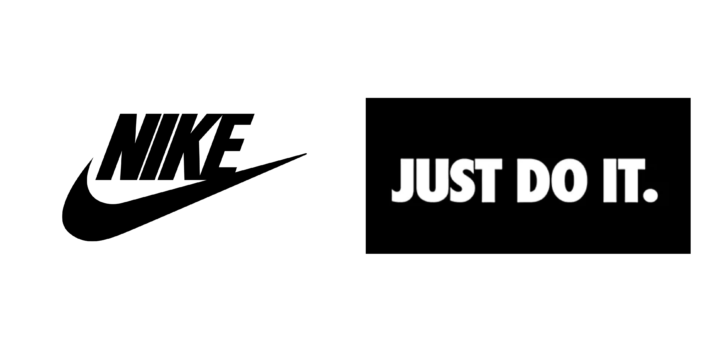
Nike’s brand voice is all about motivation and empowerment, one that uses bold language and motivational imagery to light a fire under you. Their iconic slogan “Just Do It” isn’t just a tagline, it’s a call to action, urging you to push your limits and reach your full potential. But Nike doesn’t just speak to elite athletes.
They recognise the “athlete within” everyone, positioning themselves as your supportive companion on your personal fitness journey, regardless of your starting point. Their message is one of inclusivity and empowerment, celebrating diversity and reminding everyone that anyone can step up and be an athlete.
Just check out some of their recent posts below:
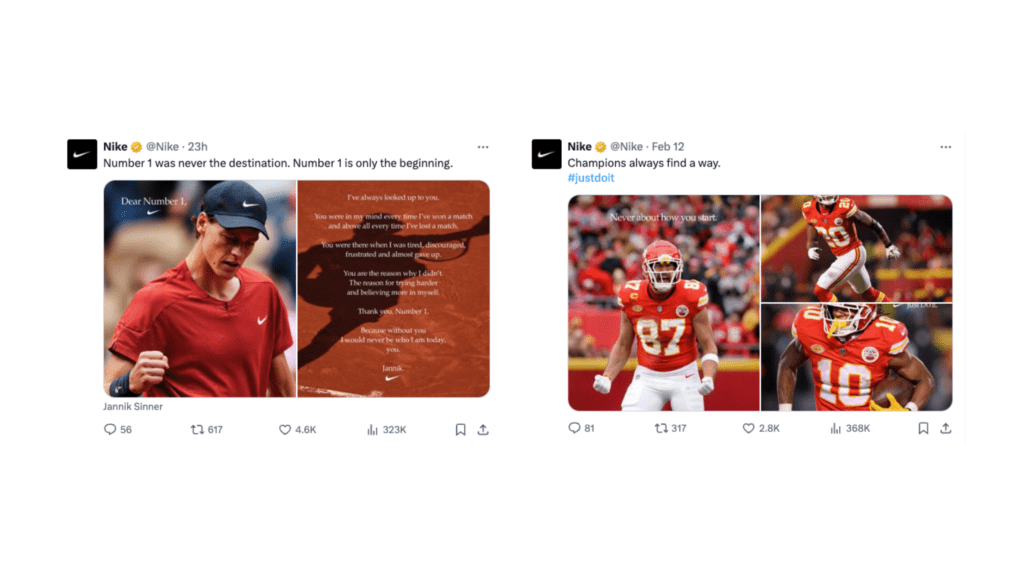
Here’s another example of a strong brand voice, completely different from Nike:
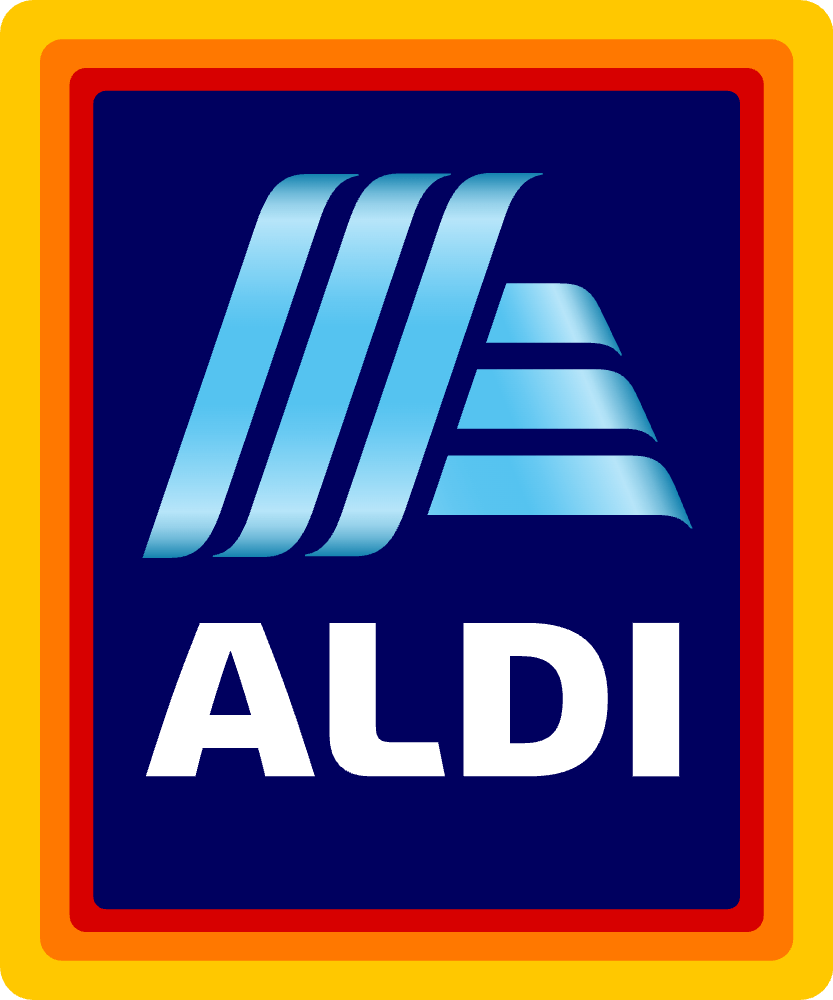
Social media is all about building relationships and creating a community. Aldi’s witty voice allows them to connect with their audience on a personal level and make them smile. It also helps them stand out from the crowd in a competitive grocery market.
You might have noticed the brand voice is very different on their website as it serves a different purpose. It’s a resource for people who are looking for specific information about Aldi. A clear and informative tone is essential for helping users find what they need quickly and easily.
Here are some examples of their brand voice on their social channels:
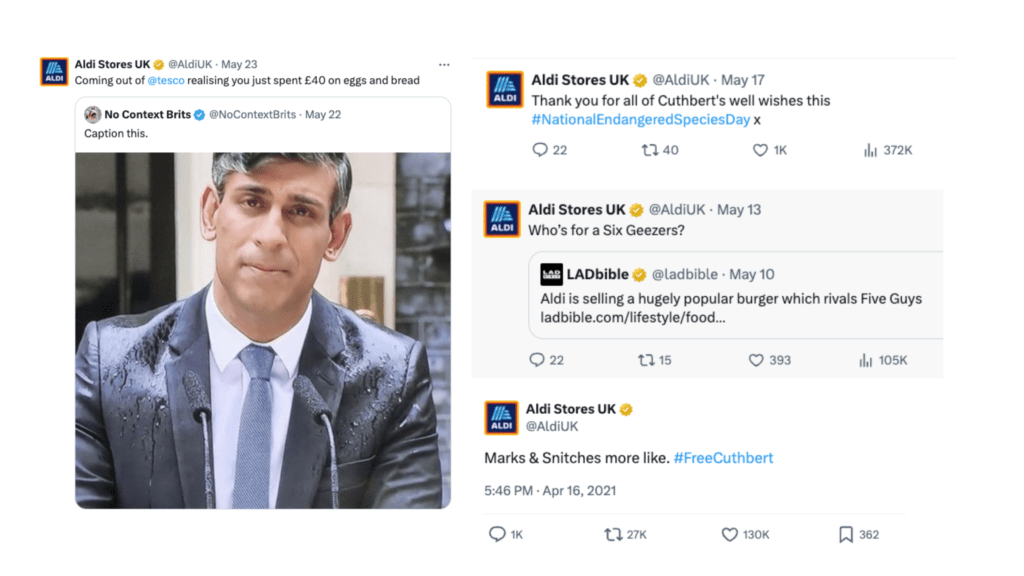
In short, Aldi understands that the right communication style depends on the context. They use humour and personality on social media to connect with their audience, while maintaining a professional and informative tone on their website.
Top Tip: Choose your TOV that your audience will relate to
Visual identity
A brand’s visual identity is all about the visual elements that create a recognisable and memorable image for the brand. It’s how they present themselves through design and imagery. This includes colours, fonts, shapes and logos.
At Xpand, we’re experts in branding and rebrands! Take a client of ours, Zip, a local taxi firm that needed a rebrand. Below is their logo, let’s see what makes this a good visual identity.

- Simple design
Simple design is a win-win for brands. It boosts memorability with clean visuals and transcends trends for lasting impact. This focus allows viewers to grasp the brand’s essence and fosters positive emotions like trust or modernity. Just like Zip’s logo, it’s simple and easy to understand.
- Modern font
Fonts play a crucial role in shaping brand identity. Modern fonts, in particular, can be a great way to signal freshness and innovation through clean lines, geometric shapes, or even a futuristic feel. This can be perfect for brands aiming to project a forward-thinking image. However, it’s important to choose wisely. Readability is key, so avoid overly complex fonts that become illegible at smaller sizes. Consider how the font will translate across different mediums like print and digital. Finally, remember that trendy fonts can fizzle out quickly. Opt for a modern font that complements your brand’s core values and resonates with your target audience.
- Colour Palette
A well-chosen palette can instantly tell viewers what your brand is all about. Bold, contrasting colours can convey energy and excitement, while muted tones might suggest sophistication or calmness. Remember to keep it simple with the number of colours you have. Too many colours and your brand won’t be recognisable. Have a look at Zip’s colour palette, there are only 2 colours, amber and black.
- Classic design
You don’t want to be thinking of rebranding a few years after your last rebrand! So choosing a classic design that isn’t jumping on trends is key. When creating your logo you want to create a brand. Think how Apple has the ‘apple’ imagery but that has nothing to do with the tech they sell. Choose more symbolic logos. This can be a powerful strategy.
- Memorable
A memorable logo is an investment in your brand’s future. It’s a visual representation that strengthens brand recognition, builds trust, and paves the way for long-term success. Zip’s logo is so simple that this is what makes it memorable.
- Versatile
A versatile logo is important. It ensures your brand presents a consistent and professional image across all touchpoints, strengthening brand recognition and memorability. It’s a logo that can grow with your brand, adapting to new marketing strategies and technological advancements. See below how Zip’s logo can be used in different ways.
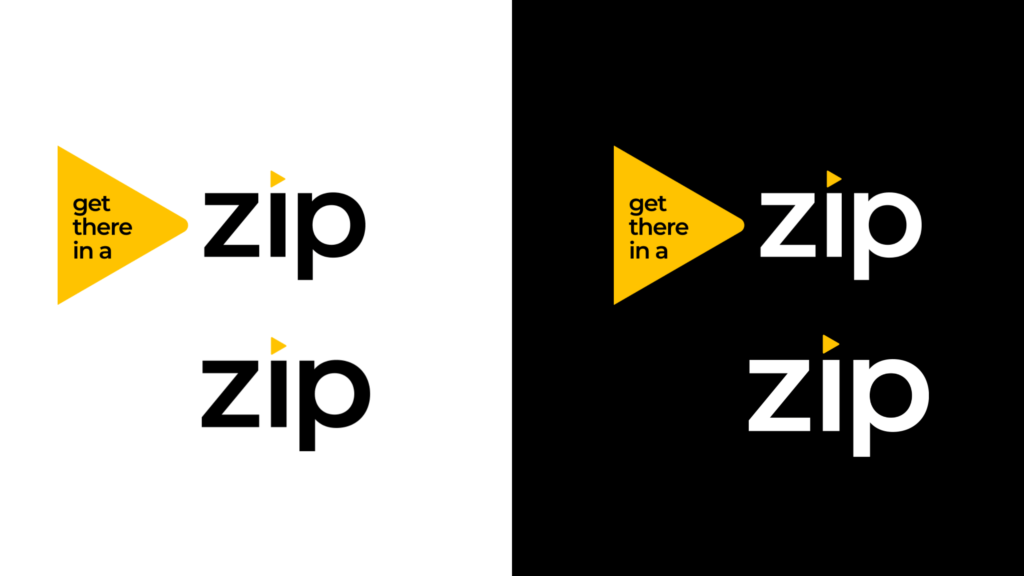
The above image shows the versatility of the logo on different coloured backgrounds as well as the logo appearing with or without the strapline.
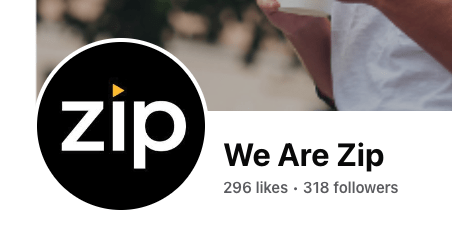
When it comes to your visual identity here are a few things you shouldn’t be doing:
Don’t:
- Jump on logo trends
These will soon go out of fashion and your visual identity will be left looking dated.
- Use too many colours
Keep to 2 main colours and 2 secondary colours. You want these to help you be recognisable. Too many colours and it will get confusing for your audience.
- Copy someone else’s branding
It’s always good to see what your competition are doing and decide what you like or don’t like about their visual identity BUT don’t copy what they’re doing. Stay original.
- Try to fit a horizontal logo into social
Make sure you have versatility in your logo. There’s nothing worse than seeing a brand online with a logo that doesn’t fit into social sizes like profile pictures. This can look messy and unprofessional.
- Add your logo to every social post
We see this all of the time! There is no reason to slap your logo on every post. From your profile picture to your brand name and your visual identity, there are many signs that identify you to your audience.
Top Tip: Develop brand guidelines to maintain visual and messaging consistency across platforms.
Brand guidelines are a great way to stay consistent with your brand’s identity and visual identity. These will tell you what font to use, which colours, which logo to use and when. Plus they can include your TOV and help guide those in your team or those outside the business.
Creating high-quality content
To create high-quality content you need to ensure you’ve aced your brand identity and your visual brand identity. Once you’ve got these two elements right then you can move on to creating quality content.
To do this follow this formula:
- Hook
Your hook is what will stop your audience from scrolling. It will be the first thing they notice about your post. This could be the first sentence of your caption, a visual hook from a video or a graphic. A caption hook could be a controversial statement that disagrees with what many believe in your industry. A visual hook could be a striking figure in your graphic, make use of surprising stats to get your audience to read your post.
The third hook is a mid-way hook. The mid-way hook can be used in captions or on videos. In your captions, a mid-way hook is a sentence that may intrigue the reader more, a part of your story that wasn’t expected. In a video, you’ll usually find a drop-off point where your audience loses interest. To keep their interest ensure to add a mid-hook to your video. This can be anything from text on the video to a change of scene or camera angle.
- Story
Remember to tell a story in your posts. A story consists of a beginning, middle and end. Don’t just give your audience a lesson, give them the story of how you learnt it and what you did to overcome problems.
As humans, we love to hear stories as they can evoke emotions and foster connection.
- Tag
Don’t forget to tag people in your posts! But there are a few rules to follow here when it comes to tagging and getting it right. One, don’t go on a tagging frenzy, only tag people who are related to your post. Two, the algorithm will rate your post badly if the people or pages you have tagged don’t respond. So make sure you know they’ll reply! And lastly, make sure to add these tags throughout the text as you reference them and not in a list at the end.
- Keywords and hashtags
These are vital to your posts being found by the right audience. Most platforms use a mixture of both, but you’ll often hear people saying hashtags are out! The rule of thumb when it comes to hashtags is to use only a handful. They want to be subject or location specific to your post. Try to make these detailed search phrases.
Keywords are woven into your captions and help the algorithm understand what the subject of your post is about so it can recommend the post to people who will be interested.
- Call to action
You will find CTAs mid-way through a post or at the end. These tell the reader what step to take next. Make it easier for your readers to know what to do next with the information you’ve given them. Ask them to follow you, like the post, or even head to your website.
- Engage
Don’t put in all this hard work for your brand and then ditch this last important step! Social media is social, make sure you’re treating it as such. Engage with your audience by going out to comment on other’s posts, reply to comments on your own posts, send DM’s and build a community. If you miss this vital step all of your prior hard work won’t help.
The secret to a powerful brand
There’s no one thing you can do to magically become a powerful brand online. You must put in the work to achieve success!
You’ve probably heard of Maslow’s hierarchy of needs, well we created Fran’s Hierarchy of Powerful Branding Online.
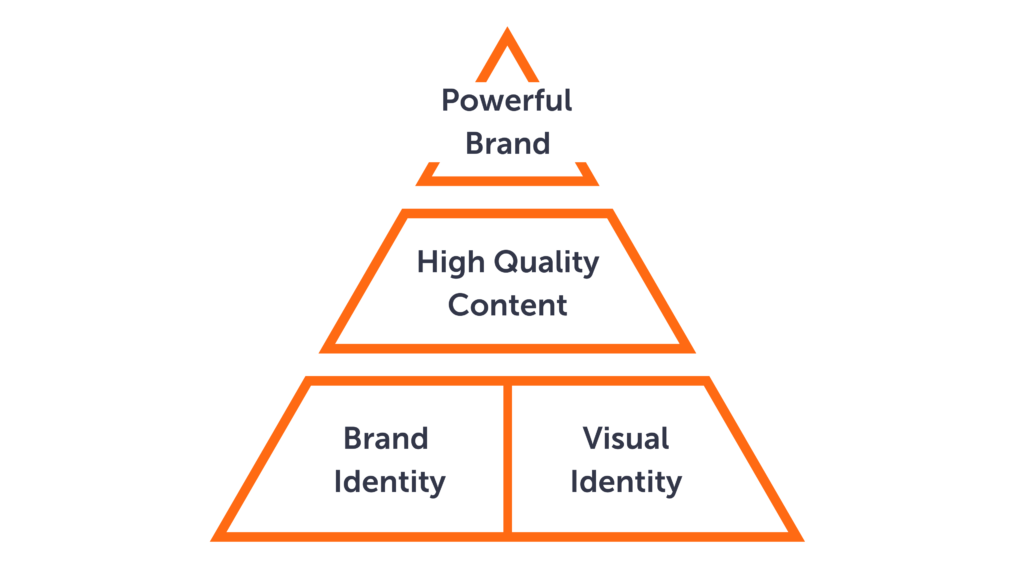
To achieve a powerful brand you must first ensure you ace your brand identity and your visual identity. Get these two elements right and then you can move up to creating high-quality content by following our formula. Once you’ve achieved these three stages, you are well on your way to being a powerful brand online!



